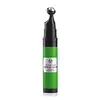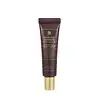What's inside
What's inside
 Key Ingredients
Key Ingredients

 Benefits
Benefits

 Concerns
Concerns

No concerns
 Ingredients Side-by-side
Ingredients Side-by-side

Water
Skin ConditioningButylene Glycol
HumectantAlcohol Denat.
AntimicrobialSorbitol
HumectantPentylene Glycol
Skin ConditioningGlycerin
HumectantPEG-20 Methyl Glucose Sesquistearate
EmulsifyingPvp
Emulsion StabilisingSilica
AbrasiveAmmonium Acryloyldimethyltaurate/Vp Copolymer
Phenoxyethanol
PreservativePullulan
Ethylhexylglycerin
Skin ConditioningOlea Europaea Fruit Oil
MaskingOrbignya Oleifera Seed Oil
EmollientXanthan Gum
EmulsifyingHydrolyzed Manihot Esculenta Tuber Extract
Skin ConditioningSodium Hyaluronate
HumectantSodium PCA
HumectantUrea
BufferingSynthetic Fluorphlogopite
Disodium EDTA
Adenosine
Skin ConditioningTrehalose
HumectantLeuconostoc/Radish Root Ferment Filtrate
AntimicrobialNiacinamide
SmoothingPolyquaternium-51
Skin ConditioningT-Butyl Alcohol
PerfumingFraxinus Excelsior Bark Extract
Skin ConditioningLeontopodium Alpinum Meristem Cell Culture
Skin ConditioningGlycolic Acid
BufferingSilanetriol
Potassium Citrate
BufferingTin Oxide
AbrasiveTocopherol
AntioxidantCitric Acid
BufferingCI 77891
Cosmetic ColorantWater, Butylene Glycol, Alcohol Denat., Sorbitol, Pentylene Glycol, Glycerin, PEG-20 Methyl Glucose Sesquistearate, Pvp, Silica, Ammonium Acryloyldimethyltaurate/Vp Copolymer, Phenoxyethanol, Pullulan, Ethylhexylglycerin, Olea Europaea Fruit Oil, Orbignya Oleifera Seed Oil, Xanthan Gum, Hydrolyzed Manihot Esculenta Tuber Extract, Sodium Hyaluronate, Sodium PCA, Urea, Synthetic Fluorphlogopite, Disodium EDTA, Adenosine, Trehalose, Leuconostoc/Radish Root Ferment Filtrate, Niacinamide, Polyquaternium-51, T-Butyl Alcohol, Fraxinus Excelsior Bark Extract, Leontopodium Alpinum Meristem Cell Culture, Glycolic Acid, Silanetriol, Potassium Citrate, Tin Oxide, Tocopherol, Citric Acid, CI 77891
Saccharomyces/Snail Secretion Filtrate Ferment Filtrate
Skin ConditioningWater
Skin ConditioningCaprylic/Capric Triglyceride
MaskingPropanediol
SolventLactobacillus/Collagen Ferment Filtrate
HumectantButylene Glycol
HumectantPolyglyceryl-3 Methylglucose Distearate
EmulsifyingNiacinamide
SmoothingCetyl Ethylhexanoate
Emollient1,2-Hexanediol
Skin ConditioningPentylene Glycol
Skin ConditioningGlyceryl Stearate
EmollientGlycerin
HumectantAcrylates/C10-30 Alkyl Acrylate Crosspolymer
Emulsion StabilisingHydroxyethylcellulose
Emulsion StabilisingOlea Europaea Fruit Oil
MaskingHelianthus Annuus Seed Oil
EmollientSodium Hyaluronate
HumectantSodium Hyaluronate Crosspolymer
HumectantHydrolyzed Sodium Hyaluronate
Skin ConditioningHydrolyzed Hyaluronic Acid
HumectantHyaluronic Acid
HumectantAcetyl Hexapeptide-8
HumectantCopper Tripeptide-1
Skin ConditioningBifida Ferment Lysate
Skin ConditioningUlmus Campestris Bark Extract
AstringentSalix Alba Bark Extract
AstringentPlantago Asiatica Extract
Skin ConditioningLaminaria Digitata Extract
Skin ProtectingDiospyros Kaki Leaf Extract
Skin ProtectingAlthaea Rosea Root Extract
HumectantAloe Barbadensis Leaf Extract
EmollientBetaine
HumectantBeta-Glucan
Skin ConditioningGlyceryl Stearate Citrate
EmollientPanthenol
Skin ConditioningGlycine
BufferingSerine
MaskingGlutamic Acid
HumectantAllantoin
Skin ConditioningAspartic Acid
MaskingLeucine
Skin ConditioningAlanine
MaskingLysine
Skin ConditioningTyrosine
MaskingPhenylalanine
MaskingValine
MaskingThreonine
Proline
Skin ConditioningIsoleucine
Skin ConditioningHistidine
HumectantMethionine
Skin ConditioningCysteine
AntioxidantArginine
MaskingCeramide NP
Skin ConditioningAdenosine
Skin ConditioningBee Venom
AstringentTocopherol
AntioxidantPolyglyceryl-3 Distearate
EmulsifyingHydrogenated Lecithin
EmulsifyingCetearyl Olivate
Sorbitan Olivate
EmulsifyingCaprylyl Glycol
EmollientSaccharomyces/Snail Secretion Filtrate Ferment Filtrate, Water, Caprylic/Capric Triglyceride, Propanediol, Lactobacillus/Collagen Ferment Filtrate, Butylene Glycol, Polyglyceryl-3 Methylglucose Distearate, Niacinamide, Cetyl Ethylhexanoate, 1,2-Hexanediol, Pentylene Glycol, Glyceryl Stearate, Glycerin, Acrylates/C10-30 Alkyl Acrylate Crosspolymer, Hydroxyethylcellulose, Olea Europaea Fruit Oil, Helianthus Annuus Seed Oil, Sodium Hyaluronate, Sodium Hyaluronate Crosspolymer, Hydrolyzed Sodium Hyaluronate, Hydrolyzed Hyaluronic Acid, Hyaluronic Acid, Acetyl Hexapeptide-8, Copper Tripeptide-1, Bifida Ferment Lysate, Ulmus Campestris Bark Extract, Salix Alba Bark Extract, Plantago Asiatica Extract, Laminaria Digitata Extract, Diospyros Kaki Leaf Extract, Althaea Rosea Root Extract, Aloe Barbadensis Leaf Extract, Betaine, Beta-Glucan, Glyceryl Stearate Citrate, Panthenol, Glycine, Serine, Glutamic Acid, Allantoin, Aspartic Acid, Leucine, Alanine, Lysine, Tyrosine, Phenylalanine, Valine, Threonine, Proline, Isoleucine, Histidine, Methionine, Cysteine, Arginine, Ceramide NP, Adenosine, Bee Venom, Tocopherol, Polyglyceryl-3 Distearate, Hydrogenated Lecithin, Cetearyl Olivate, Sorbitan Olivate, Caprylyl Glycol
Ingredients Explained
These ingredients are found in both products.
Ingredients higher up in an ingredient list are typically present in a larger amount.
Adenosine is in every living organism. It is one of four components in nucleic acids that helps store our DNA.
Adenosine has many benefits when used. These benefits include hydrating the skin, smoothing skin, and reducing wrinkles. Once applied, adenosine increases collagen production. It also helps with improving firmness and tissue repair.
Studies have found adenosine may also help with wound healing.
In skincare products, Adenosine is usually derived from yeast.
Learn more about AdenosineButylene Glycol (or BG) is used within cosmetic products for a few different reasons:
Overall, Butylene Glycol is a safe and well-rounded ingredient that works well with other ingredients.
Though this ingredient works well with most skin types, some people with sensitive skin may experience a reaction such as allergic rashes, closed comedones, or itchiness.
Learn more about Butylene GlycolGlycerin is already naturally found in your skin. It helps moisturize and protect your skin.
A study from 2016 found glycerin to be more effective as a humectant than AHAs and hyaluronic acid.
As a humectant, it helps the skin stay hydrated by pulling moisture to your skin. The low molecular weight of glycerin allows it to pull moisture into the deeper layers of your skin.
Hydrated skin improves your skin barrier; Your skin barrier helps protect against irritants and bacteria.
Glycerin has also been found to have antimicrobial and antiviral properties. Due to these properties, glycerin is often used in wound and burn treatments.
In cosmetics, glycerin is usually derived from plants such as soybean or palm. However, it can also be sourced from animals, such as tallow or animal fat.
This ingredient is organic, colorless, odorless, and non-toxic.
Glycerin is the name for this ingredient in American English. British English uses Glycerol/Glycerine.
Learn more about GlycerinNiacinamide is a multitasking form of vitamin B3 that strengthens the skin barrier, reduces pores and dark spots, regulates oil, and improves signs of aging.
And the best part? It's gentle and well-tolerated by most skin types, including sensitive and reactive skin.
You might have heard of "niacin flush", or the reddening of skin that causes itchiness. Niacinamide has not been found to cause this.
In very rare cases, some individuals may not be able to tolerate niacinamide at all or experience an allergic reaction to it.
If you are experiencing flaking, irritation, and dryness with this ingredient, be sure to double check all your products as this ingredient can be found in all categories of skincare.
When incorporating niacinamide into your routine, look out for concentration amounts. Typically, 5% niacinamide provides benefits such as fading dark spots. However, if you have sensitive skin, it is better to begin with a smaller concentration.
When you apply niacinamide to your skin, your body converts it into nicotinamide adenine dinucleotide (NAD). NAD is an essential coenzyme that is already found in your cells as "fuel" and powers countless biological processes.
In your skin, NAD helps repair cell damage, produce new healthy cells, support collagen production, strengthen the skin barrier, and fight environmental stressors (like UV and pollution).
Our natural NAD levels start to decline with age, leading to slower skin repair, visible aging, and a weaker skin barrier. By providing your skin niacinamide, you're recharging your skin's NAD levels. This leads to stronger, healthier, and younger looking skin.
Another name for vitamin B3 is nicotinamide. This vitamin is water-soluble and our bodies don't store it. We obtain Vitamin B3 from either food or skincare. Meat, fish, wheat, yeast, and leafy greens contain vitamin B3.
The type of niacinamide used in skincare is synthetically created.
Learn more about NiacinamideOlea Europaea Fruit Oil is the fixed oil obtained from the ripe fruit of the Olive. In other words - olive oil.
The primary contents of olive oil are glycerides of the fatty acids linoleic, oleic and palmitic.
Olive oil also contains antioxidants such as Vitamin E. Antioxidants may help reduce signs of aging by fighting unstable free-radical molecules. It also contains Vitamins A (retinol), D, and K.
The squalene in olive oil makes it a great emollient. Emollients help soothe and soften your skin by trapping moisture in. This makes olive oil a great skin moisturizer.
Studies show olive oil to have antibacterial and antifungal properties in low concentrations. Another study found olive oil irritated sensitive oily skin. We always recommend speaking with a professional about using this ingredient in your routine.
Due to the fatty acid content, this ingredient may not be fungal-acne safe.
Learn more about Olea Europaea Fruit OilPentylene glycol is typically used within a product to thicken it. It also adds a smooth, soft, and moisturizing feel to the product. It is naturally found in plants such as sugar beets.
The hydrophilic trait of Pentylene Glycol makes it a humectant. As a humectant, Pentylene Glycol helps draw moisture from the air to your skin. This can help keep your skin hydrated.
This property also makes Pentylene Glycol a great texture enhancer. It can also help thicken or stabilize a product.
Pentylene Glycol also acts as a mild preservative and helps to keep a product microbe-free.
Some people may experience mild eye and skin irritation from Pentylene Glycol. We always recommend speaking with a professional about using this ingredient in your routine.
Pentylene Glycol has a low molecular weight and is part of the 1,2-glycol family.
Learn more about Pentylene GlycolSodium Hyaluronate is hyaluronic acid's salt form. It is commonly derived from the sodium salt of hyaluronic acid.
Like hyaluronic acid, it is great at holding water and acts as a humectant. This makes it a great skin hydrating ingredient.
Sodium Hyaluronate is naturally occurring in our bodies and is mostly found in eye fluid and joints.
These are some other common types of Hyaluronic Acid:
Learn more about Sodium HyaluronateTocopherol (also known as Vitamin E) is a common antioxidant used to help protect the skin from free-radicals and strengthen the skin barrier. It's also fat soluble - this means our skin is great at absorbing it.
Vitamin E also helps keep your natural skin lipids healthy. Your lipid skin barrier naturally consists of lipids, ceramides, and fatty acids. Vitamin E offers extra protection for your skin’s lipid barrier, keeping your skin healthy and nourished.
Another benefit is a bit of UV protection. Vitamin E helps reduce the damage caused by UVB rays. (It should not replace your sunscreen). Combining it with Vitamin C can decrease sunburned cells and hyperpigmentation after UV exposure.
You might have noticed Vitamin E + C often paired together. This is because it is great at stabilizing Vitamin C. Using the two together helps increase the effectiveness of both ingredients.
There are often claims that Vitamin E can reduce/prevent scarring, but these claims haven't been confirmed by scientific research.
Learn more about TocopherolWater. It's the most common cosmetic ingredient of all. You'll usually see it at the top of ingredient lists, meaning that it makes up the largest part of the product.
So why is it so popular? Water most often acts as a solvent - this means that it helps dissolve other ingredients into the formulation.
You'll also recognize water as that liquid we all need to stay alive. If you see this, drink a glass of water. Stay hydrated!
Learn more about Water